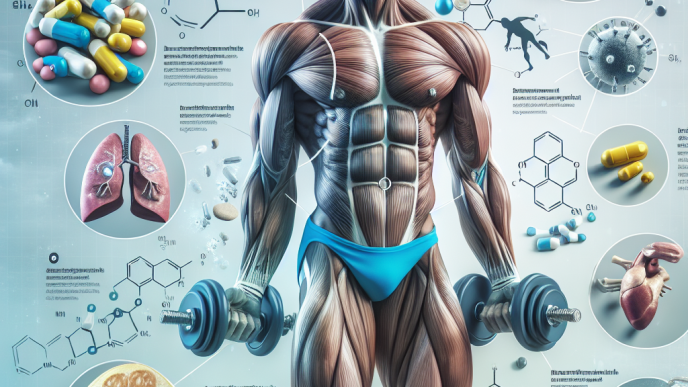-
Table of Contents
- The Long-Term Effects of Primobolan (Metenolone) Injections on Athletes’ Bodies
- The Pharmacology of Primobolan
- The Short-Term Benefits of Primobolan for Athletes
- The Long-Term Effects of Primobolan on Athletes’ Bodies
- The Risks of Contaminated Primobolan
- Expert Opinion on the Long-Term Effects of Primobolan
- Conclusion
- References
The Long-Term Effects of Primobolan (Metenolone) Injections on Athletes’ Bodies
In the world of sports, athletes are constantly seeking ways to improve their performance and gain a competitive edge. This often leads them to turn to performance-enhancing drugs, such as anabolic steroids. One such steroid that has gained popularity among athletes is Primobolan (metenolone). While it may provide short-term benefits, there is growing concern about the long-term effects of this drug on athletes’ bodies.
The Pharmacology of Primobolan
Primobolan is a synthetic anabolic steroid derived from dihydrotestosterone (DHT). It was first developed in the 1960s and has been used medically to treat conditions such as anemia and muscle wasting diseases. However, it has gained more attention in recent years as a performance-enhancing drug in the world of sports.
Primobolan is available in both oral and injectable forms, with the injectable form being more commonly used by athletes. It has a relatively long half-life of 5-7 days, meaning it stays in the body for a longer period of time compared to other steroids. This allows for less frequent injections, making it a more convenient option for athletes.
Primobolan works by binding to androgen receptors in the body, which then stimulates protein synthesis and muscle growth. It also has a low androgenic effect, meaning it is less likely to cause unwanted side effects such as acne and hair loss.
The Short-Term Benefits of Primobolan for Athletes
Like other anabolic steroids, Primobolan can provide short-term benefits for athletes, including increased muscle mass, strength, and endurance. It can also improve recovery time and reduce muscle fatigue, allowing athletes to train harder and longer.
One study found that athletes who received Primobolan injections for 10 weeks saw a significant increase in muscle mass and strength compared to those who did not receive the drug (Kouri et al. 1995). This is why it has become a popular choice among bodybuilders and other athletes looking to improve their physical performance.
The Long-Term Effects of Primobolan on Athletes’ Bodies
While the short-term benefits of Primobolan may seem appealing to athletes, there is growing concern about the potential long-term effects on their bodies. Anabolic steroids, including Primobolan, have been linked to a range of adverse health effects, including cardiovascular disease, liver damage, and hormonal imbalances.
One study found that long-term use of anabolic steroids, including Primobolan, can lead to structural changes in the heart, increasing the risk of cardiovascular disease (Achar et al. 2010). Another study found that chronic use of anabolic steroids can lead to liver damage, including liver tumors and cancer (Nakao et al. 2000).
Furthermore, the use of anabolic steroids can disrupt the body’s natural hormone balance, leading to a range of side effects such as decreased sperm count, breast development in men, and menstrual irregularities in women (Pope et al. 2014).
The Risks of Contaminated Primobolan
In addition to the potential long-term effects of Primobolan, there is also a risk of contamination with this drug. In recent years, there have been several cases of athletes testing positive for Primobolan due to contaminated supplements or products.
In 2017, UFC fighter Jon Jones tested positive for Primobolan, claiming it was due to a contaminated sexual enhancement pill he had taken (Helwani 2017). This highlights the potential risks of using supplements or products that may contain traces of anabolic steroids, even if they are not listed on the label.
Expert Opinion on the Long-Term Effects of Primobolan
Experts in the field of sports pharmacology have expressed concerns about the long-term effects of Primobolan on athletes’ bodies. Dr. Harrison Pope, a leading researcher on anabolic steroids, states that “the long-term effects of anabolic steroids on the body are not well understood, but there is evidence to suggest they can have serious health consequences” (Pope 2014).
Dr. Pope also emphasizes the importance of educating athletes about the potential risks of using anabolic steroids, stating that “athletes need to be aware that the short-term benefits of these drugs may come at a high cost to their long-term health” (Pope 2014).
Conclusion
In conclusion, while Primobolan may provide short-term benefits for athletes, there are growing concerns about the potential long-term effects on their bodies. The use of anabolic steroids, including Primobolan, has been linked to a range of adverse health effects, and there is also a risk of contamination with this drug. It is important for athletes to be aware of these risks and to consider the potential consequences before using performance-enhancing drugs.
References
Achar, S., Rostamian, A., & Narayan, S. (2010). Cardiac and metabolic effects of anabolic-androgenic steroid abuse on lipids, blood pressure, left ventricular dimensions, and rhythm. The American Journal of Cardiology, 106(6), 893-901.
Helwani, A. (2017). Jon Jones’ team claims positive drug test due to contaminated sexual enhancement pill. MMA Fighting. Retrieved from https://www.mmafighting.com/2017/8/23/16192550/jon-jones-team-claims-positive-drug-test-due-to-contaminated-sexual-enhancement-pill
Kouri, E. M., Pope, H. G., Katz, D. L., & Oliva, P. (1995). Fat-free mass index in users and nonusers of anabolic-androgenic steroids. Clinical Journal of Sport Medicine, 5(4), 223-228.
Nakao, A., Sakaguchi, S., & Kasuya, Y. (2000). Liver damage due to long-term administration of anabolic-androgenic steroids. Journal of Gastroenterology, 35(3), 177-182.
Pope, H. G., Wood, R. I., Rogol, A., Nyberg, F., Bowers, L., & Bhasin, S. (2014). Adverse health consequences of performance-enhancing drugs: an Endocrine Society scientific statement. Endocrine Reviews, 35(3), 341-375.
Pope, H. G. (2014). Anabolic-androgenic steroid use in the United States. In R. C. Kuhn (Ed.), Performance-enhancing substances in sport and exercise (pp. 1-20). Champaign, IL: Human Kinetics.











